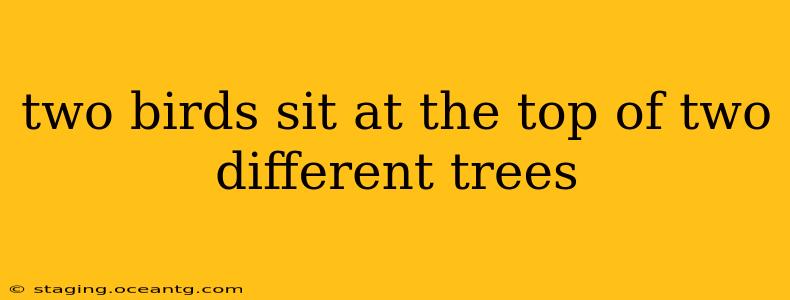Two Birds Sitting at the Top of Two Different Trees: A Deeper Look at Avian Behavior
The seemingly simple image of two birds perched atop separate trees evokes a surprising depth of potential interpretations, depending on the context. While it might appear as a mundane observation, it actually offers a glimpse into avian behavior, ecology, and even the subtle nuances of human perception. This seemingly simple scene opens the door to a world of questions.
What are the birds doing?
This is perhaps the most fundamental question. The birds' actions depend greatly on the species. Are they singing? Are they preening their feathers? Are they watching for predators or potential mates? Some birds are highly territorial, and the positioning might indicate the establishment of individual territories. Others might be simply resting or digesting a recent meal. Observation of the birds' body language – posture, head movements, and vocalizations – is crucial to understanding their behavior. For instance, a bird with its crest raised might be displaying aggression or dominance, while a bird constantly scanning its surroundings is likely alert for danger.
What kind of trees are they in?
The type of tree influences the birds' choice of location. Certain species prefer specific trees for nesting, foraging, or roosting. For example, a woodpecker might be found on a dead tree for foraging insects, while a songbird might prefer a dense tree for nesting. The trees' height and density also play a role. Taller trees provide better views of the surrounding area, increasing safety from predators, while denser trees offer better protection from inclement weather. Understanding the habitat preferences of different bird species allows us to draw inferences about the birds’ behaviors and needs.
How far apart are the trees?
The distance between the trees influences the social dynamics of the birds. If the trees are close together, the birds may be interacting, perhaps competing for resources or communicating with each other. If they are far apart, the birds are likely independent individuals with separate territories or distinct foraging areas. This distance can also affect our interpretation of their relationship. Are they a pair? Competitors? Entirely unrelated individuals?
What species of birds are they?
Bird identification is key to understanding their behavior. Different species have vastly different habits, social structures, and habitat preferences. A pair of robins will exhibit different behavior than a pair of hawks, for instance. Identifying the species helps us better interpret their actions and their context. Are they solitary or social birds? Do they engage in cooperative breeding or defend a territory fiercely? Their species identity dictates much of their behavior.
Could this be a sign of competition or cooperation?
The scenario allows for multiple interpretations. The proximity of the birds to each other, the types of trees, and the species of bird itself inform potential competitive or cooperative behaviors. Competition could occur if resources (food, nesting sites) are limited, while cooperation might be observed in species that engage in mixed-species flocks for better foraging or predator avoidance.
In conclusion, while the image of "two birds sitting at the top of two different trees" seems simple, it actually offers a rich context for studying avian behavior. To fully understand the scene, we must consider the birds' actions, the type and distance of the trees, and the species of the birds. By observing these elements, we gain insights into the intricate lives of these fascinating creatures.
